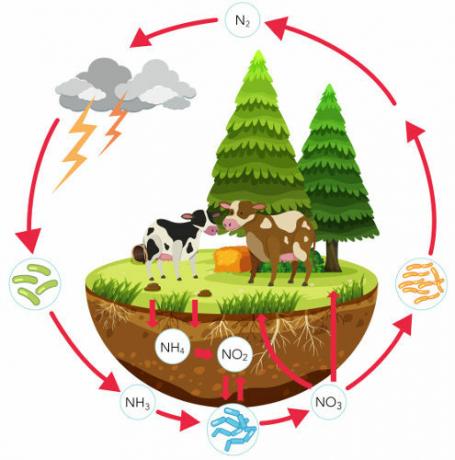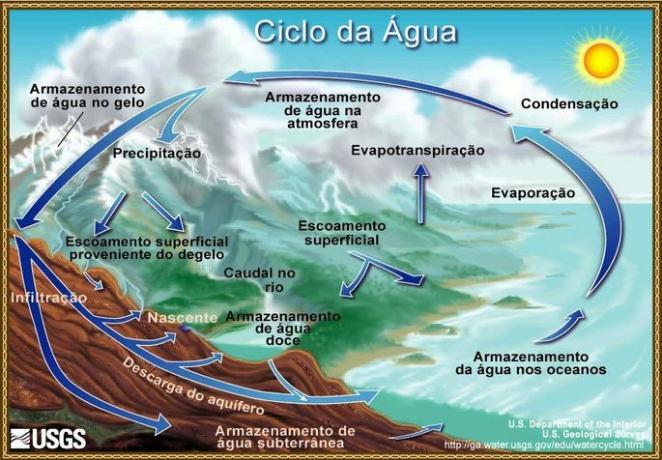Enem exams are characterized by their current themes and issues that are highly correlated with our daily lives. Therefore, It's easy to conclude that Ecology is one of the most relevant topics on the test when it comes to Biology, isn't it?
Pollution, climate change, interactions between living beings, environmental disasters and many other themes can be easily related to our daily lives. Even basic concepts are charged in a contextualized manner, as is the case with the concepts of habitat, ecological niche and trophic levels.
Mind Map: Ecology

To download the mind map in PDF, Click here!
→ Basic concepts
Elementary concepts are always covered in the Enem test and students often forget to study them. THE food chain, for example, was addressed twice in the last test by Enem (2015) and is a topic studied since elementary school. Here's one of these questions:
(Question Enem - 2015) Bioindicator or biological indicator is a species or group of species that reflects the biotic status or abiotic of an environment, the impact produced on a habitat, community or ecosystem, among others functions. The trophic position of the bioindicator organism is one of the most relevant characteristics regarding its degree of importance for this function: the lower the trophic level of the organism, the greater its usefulness, since it is assumed that the entire trophic chain is contaminated from from him.
ANDRÉA, M. M. Ecotoxicological bioindicators of pesticides. Available at: www.biologico.sp.gov.br. Accessed on: 11 mar. 2013 (adapted).
The most suitable group of organisms for this condition, from the point of view of their position in the food chain, is constituted by
a) algae.
b) fish.
c) whales.
d) shrimps.
e) anemones.
Resolution:
The answer to this question is the letter A because producers constitute the most basic trophic level in a chain.
In addition to the theme of food chain and trophic levels, we can mention as important concepts the understanding of what habitat and ecological niche and the differentiation of the terms species, community, population and biosphere.
→ Environmental problems
You environmental problems always appear in the Natural Science tests. Environmental problems themselves may be addressed or related to other areas of biological knowledge.
Below is an example of a 2015 Enem question that addressed a little bit about the environmental problems caused by the inappropriate dumping of substances in aquatic environments.
Do not stop now... There's more after the advertising ;)
(Question Enem - 2015) The textile industry uses a large amount of dyes in the fabric dyeing process. The darkening of river waters caused by the discharge of these dyes can trigger a series of problems in the aquatic ecosystem.
Considering this darkening of the waters, the initial negative impact that occurs is (a)
a) eutrophication.
b) algae proliferation.
c) inhibition of photosynthesis.
d) photodegradation of organic matter.
e) increase in the amount of dissolved gases.
Resolution:
The answer to this question is the letter C, since the darkening of the water prevents the passage of sunlight and, consequently, causes a decrease in the photosynthesis.
→ Biogeochemical cycles
You biogeochemical cycles they are the natural processes in which the circulation of a certain element between living beings and the environment is observed. These cycles are often charged, as they are responsible for recycling the elements. Among the cycles that most appear in tests, we can mention the water cycle, carbon, oxygen and nitrogen.
See an issue from Enem 2015 that addresses the nitrogen cycle:
(Question Enem - 2015) Nitrogen is essential for life and the largest global reservoir of this element, in the form of N2, is the atmosphere. The main responsible for its incorporation into organic matter are N-fixing microorganisms.2, which occur freely or symbionts with plants.
ADUAN, R. AND. et al. The planet's great biogeochemical cycles. Planaltina: Embrapa, 2004 (adapted).
Animals guarantee their metabolic needs for this element by
a) absorption of nitrogen gas by breathing.
b) intake of vegetable carbohydrate molecules.
c) incorporation of dissolved nitrites in the consumed water.
d) transfer of organic matter through trophic chains.
e) protocooperation with nitrogen-fixing microorganisms.
Resolution:
Some bacteria are able to fix nitrogen in plants, others, however, oxidize the nitrogen to nitrites and nitrates, which are used by plants, algae and bacteria. When an animal uses these plants for food, nitrogen is absorbed by it. The same happens when an animal feeds on an herbivore. Therefore, the correct answer is letter d.
Now that you know how Ecology issues are on Enem, just review this content. Remember to be aware of current events in this area, always trying to relate them to the syllabus.
Good test!
By Ma. Vanessa dos Santos
Would you like to reference this text in a school or academic work? Look:
SANTOS, Vanessa Sardinha dos. "Ecology in the Enem exams"; Brazil School. Available in: https://brasilescola.uol.com.br/biologia/ecologia-nas-provas-enem.htm. Accessed on June 27, 2021.
Biology

Learn more about the nitrogen cycle, an important biogeochemical cycle that ensures the circulation of this element. In this text, we will address each step of the nitrogen cycle, discuss its importance, and focus on the role of bacteria in this process. We will also present exercises on the subject.


